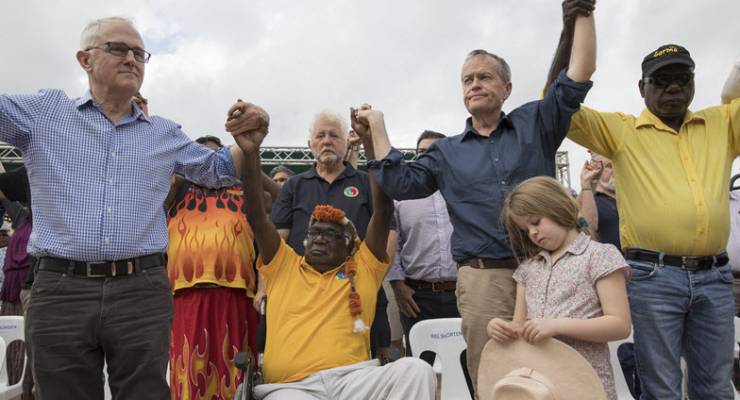
The Turnbull government’s refusal to back a “yes” vote on a referendum package from the Uluru Statement from the Heart meeting — a combination of constitutional recognition, treaty, and advisory assembly — is politically predictable. Though the speed with which it was done is affronting, it’s surprising anyone is so surprised. What chance was there that a Coalition with the National Party in it would ever consent to such a thing? Some polling currently being spruiked around suggests that support for an advisory body, established in the constitution, is as high as 60%, getting to the levels of support enjoyed by a minimal “recognition” statement alone.
Maybe, maybe, but one remains sceptical that such a vote would hold, or that it could prevail, in four states. Quite aside from the possibility that some do not understand what is being proposed, there is also the damage that a long referendum campaign would do to the idea. For the Nats, and many Liberals, the notion is anathema by principle and by politics. Even if they were, by some Merkel-esque leap of history, to grasp the proposal, their backbench would not go with them, nor would their base. One Nation would reap the harvest.
Now, with a years-long process terminated with extreme brevity, all sorts of political marsupials are off and running. Did the more experienced, “corridors-of-power” leaders know that notions of an assembly/voice would never get up — but wanted it to be refused outside the process rather than in? Are they banking on a Labor government coming along, to put it forward, in 2019? Did they always want a minimal recognition model to come through? Is this another one of Pearson’s “cunning plans” — less black leader, more Baldrick?
Who knows? But beyond all that malarkey, it has to be said, there are problems with the politics of the tripartite proposal the Uluru meeting put forward. Recognition is a strange beast; emerging from the Howard years, this proposal was to let a white settler constitution confer identity on the people whose vanquishment that constitution was the key product of. It acquired a bit more sense when the notion of a treaty was added to. That had its own wobbles, but it at least supplied a notion of reciprocity and mutual recognition. Two peoples occupying one continent and state would recognise each other as bound together by difference, and thus with a shared (though not unitary) future.
Then the advisory body proposal came along. Apparently, it was a product of the consultation process leading up to the Uluru conference. That has to be respected, but at the same time, the proposal is also bewildering. What seems structurally odd about an advisory body proposal is that it would be a hard-fought referendum point, increase the risk of loss, create new divisions among indigenous leaders as the proposal was fleshed out — and all for a body that, by its very definition, has already renounced power. Worse, its structural role appears to be cemented in a form of petition and supplication to the existing power structure.
It gives the appearance of being in the game, but changes no power relations — thus making acts of clear opposition all the more difficult to organise. Furthermore, neither Rudd, Gillard, Abbott nor Turnbull governments have taken advice from Indigenous people as a whole over the last 10 years, when it did not suit them. Had they done so, Rudd would have knocked the “Intervention” on the head, as soon as it was begun. Instead, it was continued in a modified, “rational” Labor form, and the current ghastly sadistic mess in regional/remote community policy is the result. I am sure that an advisory body might provide a critical mass to unify an Indigenous position. But it could also undermine it, by rewarding the most sycophantic and accommodating members. Surely the instructive irony is this: the provisional Indigenous advisory body advised to the government the creation of an advisory body — advice that the government peremptorily rejected in an insulting fashion.
There also appears to be an imbalance built into this process — one in which Indigenous people do all the explicit proposing of new forms, and the settler state accepts or rejects them. That looks like a process that confers power on Indigenous people, but, in a curious way, it does the opposite. But it, too, turns the Indigenous side into a petitioner, asking the white sovereign to, by acceptance of proposals, grant recognition. It is thus a ceding of collective political selfhood, which is why the Turnbull’s simple political calculus has the appearance of an annihilating act.
We may have gone about this the wrong way. If treaty is to be at the core of this process, then it has to be a genuinely reciprocal in its derivation — settler proposals must be put to the Indigenous side, as much as vice versa. Because the treaty is occurring after the total military and political defeat of one side, its enactment must be of a process that clearly demands something of both sides. Otherwise, it simply becomes a historical gift certificate, given by the conqueror to the conquered. It quickly becomes as hollowed out as recognition alone would be. Maybe, eventually, out of all this, something resembling politics beyond statecraft might emerge.








Crikey is committed to hosting lively discussions. Help us keep the conversation useful, interesting and welcoming. We aim to publish comments quickly in the interest of promoting robust conversation, but we’re a small team and we deploy filters to protect against legal risk. Occasionally your comment may be held up while we review, but we’re working as fast as we can to keep the conversation rolling.
The Crikey comment section is members-only content. Please subscribe to leave a comment.
The Crikey comment section is members-only content. Please login to leave a comment.